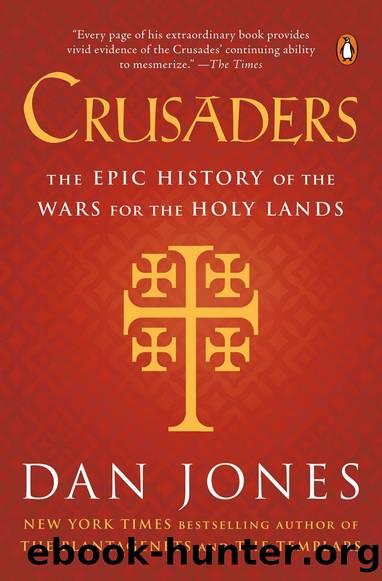Crusaders: An Epic History of the Wars For the Holy Land by Dan Jones

Author:Dan Jones [Jones, Dan]
Language: eng
Format: epub
ISBN: 9780143108979
Barnesnoble:
Publisher: Head of Zeus
Published: 0101-01-01T00:00:00+00:00
*
As Frederick and his imperial troops mobilized, Henry II of England â who had declined to abdicate his western crown to assume command of Jerusalem â was now finally shamed into taking the cross. He did so in January 1188, after making peace with the young king of France, Philip II âAugustusâ, who had succeeded his father Louis VII in 1180. The two kings â perpetually at war â agreed to cease attacking one anotherâs territories, and to levy on their subjects a 10 percent income tax known as the âSaladin Titheâ, to pay for the relief of Christendom. Henryâs energetic and bellicose son Richard, count of Poitou â soon to be known by his sobriquet âLionheartâ â had already taken the cross, making his vows in November 1187, the day after he heard of the fall of Jerusalem. As it transpired, it was Richard who came to lead the English contingent of the Third Crusade, for on 6 July 1189 Henry died in Chinon Castle.
As befitted both his nickname and his famous parents, Richard was a force of nature. According to a romantic pen portrait recorded after his death by the author of a chronicle known as the Itinerarium Peregrinorum, Richard was âtall, of elegant build; the colour of his hair was between red and gold; his limbs were supple and straight. He had quite long arms, which were particularly effective for drawing a sword and wielding it.â Riding before an army, said the same author, Richard wore a fine red cap in the Flemish style, a tunic of rose samite and a cloak covered with little silver half-moons and shining suns. âThe sight of him was a pleasure to the eyes.â14 Less starry-eyed writers noted that in fact Richard was pale-faced, carried too much fat, and suffered with ulcers and fevers.15 What everyone agreed upon, however, was his extreme love of and talent for warfare, into which he threw himself headlong from his teens until his dying day. Gerald of Wales wrote that he physically trembled with nervous energy, âand his trembling makes the whole world tremble and fearâ.16 History called him to the crusade at the right moment and Richard answered the call with all he had.
Richard was crowned on 3 September, and immediately began a fire-sale of public offices and crown possessions to raise crusading funds. At the same time royal officials frantically stockpiled the necessary goods for the long journey: hundreds of thousands of salted pig carcasses, wheels of cheese, beans, biscuits, wineskins and barrels of ale, fodder for horses, horseshoes and nails, arrowheads and crossbow bolts.17 Crusade preachers roamed the British Isles targeting the most talented warriors to join the army: the archbishop of Canterbury Baldwin of Forde raised around 3,000 men on a circuit of Wales.18
Richardâs impatience to torment the infidel rapidly infected the English populace, and led to months of riots against Englandâs Jews, which started on Richardâs coronation day and culminated in York in March 1190 when several hundred Jewish people were burned alive by a mob while supposedly under royal protection in the cityâs castle.
Download
This site does not store any files on its server. We only index and link to content provided by other sites. Please contact the content providers to delete copyright contents if any and email us, we'll remove relevant links or contents immediately.
| Buddhism | Christianity |
| Ethnic & Tribal | General |
| Hinduism | Islam |
| Judaism | New Age, Mythology & Occult |
| Religion, Politics & State |
Cecilia; Or, Memoirs of an Heiress — Volume 1 by Fanny Burney(31338)
Cecilia; Or, Memoirs of an Heiress — Volume 3 by Fanny Burney(30935)
Cecilia; Or, Memoirs of an Heiress — Volume 2 by Fanny Burney(30891)
The Secret History by Donna Tartt(16635)
Sapiens: A Brief History of Humankind by Yuval Noah Harari(13059)
Leonardo da Vinci by Walter Isaacson(11907)
The Radium Girls by Kate Moore(10910)
Sapiens by Yuval Noah Harari(4540)
The Wind in My Hair by Masih Alinejad(4426)
How Democracies Die by Steven Levitsky & Daniel Ziblatt(4401)
Homo Deus: A Brief History of Tomorrow by Yuval Noah Harari(4282)
Endurance: Shackleton's Incredible Voyage by Alfred Lansing(3845)
The Silk Roads by Peter Frankopan(3764)
Man's Search for Meaning by Viktor Frankl(3636)
Millionaire: The Philanderer, Gambler, and Duelist Who Invented Modern Finance by Janet Gleeson(3572)
The Rape of Nanking by Iris Chang(3518)
Hitler in Los Angeles by Steven J. Ross(3439)
The Motorcycle Diaries by Ernesto Che Guevara(3338)
Joan of Arc by Mary Gordon(3260)
